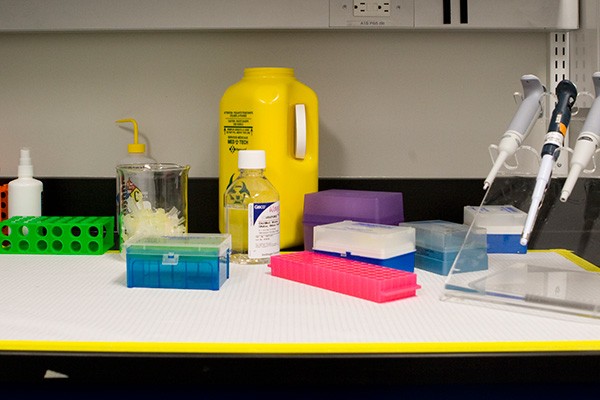Environmental, Health & Safety:
514-848-2424, ext. 4877
Biohazardous waste disposal procedures

What are they?
Biohazardous / biomedical waste refers to any material having the risk of carrying pathogens which can potentially harm humans. The biohazardous wastes generated at Concordia University include:
- Human and animal blood and blood products
- Cultures and stocks of etiologic agents and associated biologicals
- Laboratory waste that has come in contact with a biohazard. This includes but is not limited to culture dishes, blood specimen tubes, devices used to transfer, inoculate and mix cultures, and other materials which have come in contact with biohazards (including disposable personal protective equipment and clothing)
- Sharps that have been in contact with biological materials
- Animal waste, animal carcasses and body parts
Any solid biohazardous waste material should be placed in an appropriate bag / container, which bears the biohazard symbol. The following containers should be used for their disposal:
Sharps:
- Container: 4 litres (yellow container)
- Material: plastic
- Use: needles, scalpels, syringes, Pasteur pipets
Non-anatomical waste:
- Container: Grey bins with yellow plastic bags
- Material: plastic
- Use: Non-anatomical waste only, blood products, fixed tissues
- No anatomical waste / carcasses / body parts
- No loose sharps, needles or slides
- No breakable glassware
- No radioactive materials
- No chemical waste / drugs
- No regular waste
Anatomical waste:
- Container: 20L red pails
- Material: plastic
- Use: anatomical waste only
- animal tissues
- any material contaminated with animal tissues
Animal carcasses must be placed in bags that are then stored in the designated biohazardous freezer located in CSBN. All the data concerning that waste should also be recorded at the same time in the logbook located near the freezer.
The biohazard waste sharps containers can be obtained from the Central Chemistry Store (SP-132.02) for Loyola Campus or EHS for SGW Campus. For other biohazard waste containers, please contact EHS at hazardouswaste@concordia.ca.
For more details concerning biohazard waste procedures, please refer to the following documents:
- Biohazard Waste Disposal Guidelines English/French
- Biohazard Waste Grey Bin Procedure
a. Autoclave
- Autoclaves are ideal for decontaminating biohazardous waste prior to disposal with other refuse.
- Please make sure to follow the manufacturer’s procedures before autoclaving any biohazardous wastes. For general autoclave guidelines, please refer to the Biosafety Manual.
- Once autoclaved, material such as culture dishes can be disposed of with the regular garbage. However, the autoclave bag and its content must be placed inside a regular tied-up garbage bag.
- Never put an autoclave bag or its content directly in the regular garbage.
b. Chemical Decontamination
- Cell culture waste can be destroyed by mixing them with water and bleach (0.5%– 1% v/v) and letting them sit in a capped container for 24-48 hours at room temperature. The waste may then be dumped down the sink in a chemical hood with fresh tap water running for a few minutes after dumping the bleached waste.
- Chemical disinfectants are used for the decontamination of surfaces and equipment that cannot be autoclaved, such as reusable glassware, specimen containers, and spill clean-up. The choice of disinfectant will depend upon the resistance of the microorganisms, practicability, stability, compatibility with the materials, and the health hazards.
Please refer to the Biosafety Manual
- Do not overfill biohazard waste containers; dispose the containers when they are 2/3 full.
- If required, research laboratories can use other types of biohazard waste containers at their own expenses, as long as they are designed for the disposal of such wastes. These containers will also be picked up during regular pick-up rounds.
Once you have biohazardous wastes ready to be picked-up, the following procedure must be followed:
- Make sure to close properly all waste containers to avoid contamination outside the working area once the containers are being picked-up.
- Clearly identify any containers that contain animal carcasses.
- Send the information for pick-up by e-mail to hazardouswaste@concordia.ca.
- Regular biohazardous waste pick-ups are to be done on scheduled rounds only:
- Loyola campus: within 24-48h after request
- SGW campus: by every Thursday
- Loyola campus: within 24-48h after request
- The biohazardous freezer located in CSBN is to be emptied on an every second-week schedule.
Request for special biohazardous waste pick-ups (emergency) must be sent directly to the EHS office by e-mail to hazardouswaste@concordia.ca.







